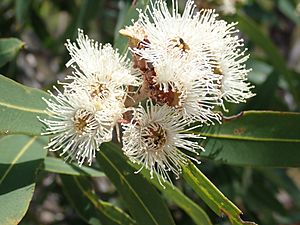Angophora bakeri subsp. crassifolia facts for kids
Quick facts for kids Angophora bakeri subsp. crassifolia |
|
|---|---|
 |
|
| Flowers of Angophora bakeri subsp. crassifolia in Ku-ring-gai Chase National Park | |
| Scientific classification |
|
| Kingdom: | Plantae |
| Clade: | Tracheophytes |
| Clade: | Angiosperms |
| Clade: | Eudicots |
| Clade: | Rosids |
| Order: | Myrtales |
| Family: | Myrtaceae |
| Genus: | Angophora |
| Species: | |
| Subspecies: |
A. b. subsp. crassifolia
|
| Trinomial name | |
| Angophora bakeri subsp. crassifolia G.J.Leach
|
|
| Synonyms | |
|
|
The Angophora bakeri subsp. crassifolia is a special type of small tree or shrub. It is also known as a mallee, which means it has many stems growing from the ground. This plant is found only in a small part of New South Wales, Australia.
It has rough bark on its trunk and branches. Its leaves are thick and shaped like a spear. The flowers are white or creamy white. They grow in small groups. After flowering, it produces cup-shaped fruits. This plant is a bit like another type called subspecies bakeri. However, crassifolia is smaller, has thicker leaves, and slightly bigger fruit.
What it Looks Like
Angophora bakeri subsp. crassifolia is a small tree or mallee. It usually grows up to 10 m (33 ft) tall. It has a special woody swelling at its base called a lignotuber. This helps it regrow after fires.
Its bark is rough and stringy on both the trunk and branches. Young plants have oval-shaped leaves. These leaves are about 50–80 mm (2.0–3.1 in) long and 10–20 mm (0.39–0.79 in) wide. They grow directly from the stem in opposite pairs.
Adult leaves also grow in opposite pairs. They are a lighter green color underneath. These leaves are thick and stiff. They are shaped like a lance or are slightly curved. They measure 50–110 mm (2.0–4.3 in) long and 10–20 mm (0.39–0.79 in) wide. Each leaf has a short stalk, called a petiole, which is 4–10 mm (0.16–0.39 in) long.
The flower buds grow at the ends of the branches. They are found in groups of three or seven. Each group sits on a main stalk, called a peduncle, which is 8–20 mm (0.31–0.79 in) long. Each individual flower bud has its own small stalk, called a pedicel, about 7–10 mm (0.28–0.39 in) long.
Mature buds are round. They are about 5–7 mm (0.20–0.28 in) long and wide. The petals are white with a green line down the middle. They are about 3 mm (0.12 in) long and 4 mm (0.16 in) wide. This plant flowers from November to January. Its fruit is a cup-shaped or barrel-shaped capsule. The fruit is 9–10 mm (0.35–0.39 in) long and 9–12 mm (0.35–0.47 in) wide. The parts that open to release seeds are hidden inside the fruit.
This subspecies crassifolia is different from subspecies bakeri. It is a smaller plant. Its leaves are thicker and not as bendy. Also, its fruit is a little bit bigger.
How it Got its Name
The plant Angophora bakeri was first officially described in 1913. This was done by a person named Edwin Cuthbert Hall. Later, in 1986, Gregory John Leach described two different types, or subspecies, of this plant. One of these was subspecies crassifolia. He wrote about it in a science journal called Telopea.
The first samples of this plant were collected by Leach in 1975. He found them near Mona Vale Road in Terrey Hills, New South Wales. The second part of the plant's name, crassifolia, comes from Latin. Crassus means "thick" and folium means "leaf". So, crassifolia means "thick-leaved".
Where it Grows
Subspecies crassifolia grows in sandy soil. This soil is found over sandstone rock. You can find it in areas north of Middle Harbour. It also grows in Ku-ring-gai Chase National Park. This type of plant does not seem to grow in the same places as subspecies bakeri.

